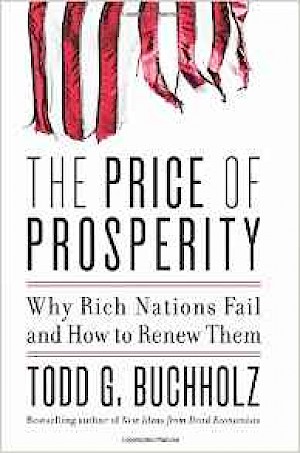09 November 2016
The Price of Prosperity
Why Rich Nations Fail and How to Renew Them
Todd G Buchholz
2016, Harper Collins, 384 pages,
ISBN 9780062405708
Reviewer: Matthew Whittaker, Chief Economist, Resolution Foundation

When a book ranges from telling you that Japanese shops sell more adult nappies than baby ones to explaining why wheels were banned in the country until the mid-19th century – with a tour round Cuba, the Renaissance Republic of Ragusa and the Ottoman Empire on the way – you know you are in for an entertaining, if sprawling read. When it is written by a former White House director of economic policy and deals – in election year – with the question of America’s ‘greatness’, you can also be sure that it will be worth paying attention to. By presenting a paradox whereby rich countries must choose between ‘declining relative wealth’ and ‘fraying cultural fabric’, Todd G Bucholz’s The Price of Prosperity certainly provides important insights into the apparent disillusionments underpinning the Brexit vote and the rise of Trump.
In truth, it is more like two – or perhaps two and a half books – than one. The first part sets out evidence pertaining to what Bucholz calls the ‘shattering forces’ afflicting rich nations through history. These forces comprise the central thesis behind the price of prosperity, which is that periods of economic growth cause countries to slow their population growth and therefore age and borrow too much, necessitating an influx of immigration which can (he is careful not to say ‘must’) splinter the dominant culture and usher in decay.
It’s a bold – and not incontestable – thesis but, in setting out his case, his coverage of the challenges of globalisation, technological change, rising inequality and intergenerational inequities is better than many other offerings out there. For instance, his focus on the decline in geographical mobility among younger Americans (while the book spans the globe, most of his contemporary examples relate to the US) is fascinating. It informs us that today’s young people are one quarter less likely to get driving licences than their parents were at the same age and 40 per cent less likely to move to another state.
Yet his argument quickly runs into trouble. By describing the decline of state after state over the course of history, he makes clear that nations fail for a whole variety of reasons – and that many prosperous ones survive (and thrive) for centuries. As the book proceeds, his own political bias also becomes more apparent. He bemoans the tendency of countries to get bogged down in bureaucracy as they get richer, losing some of the hunger that feeds growth. Yet he is silent on the possibility that an advanced state might choose to trade some GDP growth for a sharper focus on the health, safety and wellbeing of its citizens – or the examples of countries that match intervention with strong growth.
The inconsistency in his argument becomes clearer still as he moves into the second part of the book. This comprises a series of case studies of ‘great leaders’ who unified or rekindled nations over the course of history. He eschews some obvious choices, preferring instead to look at Alexander the Great, Atatürk, the Meiji Revolution in Japan, Don Pepe’s Cuba and Golda Meir. He treats them all with humour and it’s a useful way of brushing up on some lesser known aspects of world history. But the ‘lessons’ he draws for today’s leaders are often dubious – particularly as he admits that, “Just about every one of them had the stubborn smudge of gunpowder on his or her hands.”
If there is a theme to the qualities he draws out, it is an obstinate preparedness to push against opposition in order to impose a new sense of identity on a people – an identity which often looks to the past rather than the future. He celebrates revolution where it leads to a better outcome, but argues for the preservation of traditional values once ‘liberty’ has been secured. And throughout, it is at the behest of the ‘great leader’ to determine when the time is right to consolidate rather than keep pushing change.
It is the benign dictator approach to democracy, doing what is best for the people even if they don’t realise it. And it is underlined by the final mini section of the book – a manifesto which calls for a range of obligations on citizens and governments. These include a resolution to protect against “overwhelming cultural incursions”, the re-establishment of ‘noble lies’ to engender shared values and a requirement for all applicants for citizenship to have their passports stamped at no fewer than five historical landmarks spanning the States.
There are some interesting ideas in here – such as mobility credits for job seekers – and many (on the right at least) will find much to agree with. There is certainly a striking similarity with Theresa May’s recent rejection of the notion of the concept of being a citizen of the world as being something worth aspiring to. But ultimately, his call to preserve his specific version of American-ness exposes his preference for dealing with the challenges set out in the first half if his book by pressing pause (or even winding the clock back a couple of decades), rather than letting the new America find its own way. The reader’s enjoyment of the book rests in no small part on how much they agree with that perspective.
Yet, whatever the merits of the case he presents, the book is well written, entertaining and thought provoking. Fans of structure might be dismayed by what at times feels like little more than a collection of fun anecdotes that only loosely coalesce around the idea of growth and decline – yet somehow the multitude of angles works. Much like the modern state perhaps.
